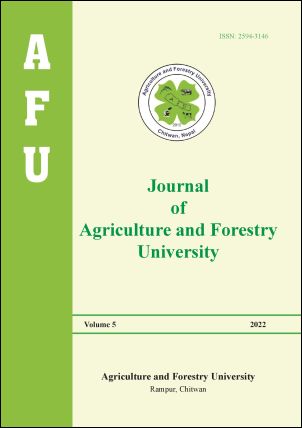Host plant preference by the fall armyworm, Spodoptera frugiperda (J.E. Smith) (Noctuidae: Lepidoptera) on the range of potential host plant species
DOI:
https://doi.org/10.3126/jafu.v5i1.48437Keywords:
Fall armyworm, agroecology, habitat management, trap crops, push-pull strategyAbstract
Maize is the most important cereal crop after rice and wheat in Asia. Nowadays, maize production is threatened by one invasive pest, the fall armyworm (Spodoptera frugiperda) particularly in Africa and Asia, and threatens millions of poor people. Fall armyworm feeds a wide range of crops and non-crops including weeds, with over 353 plant species. But most frequently consumed crops are field corn, sweet corn, wheat, sorghum, sugarcane, Bermuda grass etc. Fall armyworm has six larval stages, the first three stages are less voracious compared to the latter stages. Larvae are very numerous and disperse in large numbers and behave like ‘armyworm’. Insecticides are considered an important tool of FAW management as well as other lepidopteran maize pests. However, these practices are not sustainable and are linked to the environment, biodiversity and farmers' health. Alternative management strategies should be developed by understanding pest biology and ecology. Hence, a series of laboratory choice and paired-choice tests were conducted at Agriculture and Forestry University in May 2021 to evaluate the host plant preference by the fall armyworm. Potential host plants were Zea mays (maize cultivars - Rampur composite, Arun-2 and Rampur hybrid-10), Pennisetum purpureus (Napier), Oryza sativa (rice), Sorghum bicolor (Sorghum), Fagopyrum esculentum (Buckwheat), Vigna unguiculata (Cowpea) and Glycine max (Soybean). In choice tests, FAW preference was ranked as Rampur Composite > Sorghum > Rampur hybrid-10 > Arun-2 > Napier > Rice > Buckwheat > Cowpea > Soybean. Rampur composite and sorghum were the most preferred host plants, Rampur hybrid, Arun-2 and Napier were the medium preferred, rice was categorized as the low preferred and other host plants such as buckwheat, cowpea and soybean were the least preferred host plant of fall armyworm. In paired-choice tests, Rampur composite was more preferred than sorghum, but not significantly so. These research findings are useful to utilize in habitat manipulation strategies for fall armyworm management. Most preferred plant species can be deployed as trap crops and least preferred host plants can be used as repellent or push crops in a push-pull strategy. Such host plants in-and-around the main field can reduce the fall armyworm damage and reduce pesticide amount in main crops.
Downloads
Downloads
Published
How to Cite
Issue
Section
License
Copyright (c) 2022 Agriculture and Forestry University (AFU), Rampur, Chitwan, Nepal

This work is licensed under a Creative Commons Attribution-NonCommercial 4.0 International License.
This license allows reusers to distribute, remix, adapt, and build upon the material in any medium or format for noncommercial purposes only, and only so long as attribution is given to the creator.




